Comparison of Selected Costs in Greenhouse Cucumber Production with LED and HPS Supplemental Assimilation Lighting
Abstract
1. Introduction
2. Materials and Methods
2.1. Parameters of the Greenhouse Experiment
2.2. Gross Margin Model
- GM—gross margin expressed as a percentage,
- TR—total revenue in EUR,
- TVC—total variable cost in EUR,
- P—cumber price per kg in EUR,
- Q—cucumber quantity produced in kg.
- Δk—increase in costs,
- Δx—increase in production,
- K0—costs of the base period (2015),
- X0—production of the base period (2015).
- Wzk = 1—proportional variable cost,
- Wzk < 1—degressive variable cost,
- Wzk > 1—progressive variable cost.
3. Results
4. Discussion
5. Conclusions
Author Contributions
Funding
Conflicts of Interest
References
- Svatoš, M. Global consequences of sustainable development of agriculture. Agric. Econ. Czech 2005, 51, 20–26. [Google Scholar] [CrossRef]
- Canakci, M.; Akinci, I. Energy use pattern analyses of greenhouse vegetable production. Energy 2006, 31, 1243–1256. [Google Scholar] [CrossRef]
- Mohammadi, A.; Omid, M. Economical analysis and relation between energy inputs and yield of greenhouse cucumber production in Iran. Appl. Energy 2010, 87, 191–196. [Google Scholar] [CrossRef]
- Heidari, M.D.; Omid, M. Energy use patterns and econometric models of major greenhouse vegetable productions in Iran. Energy 2011, 36, 220–225. [Google Scholar] [CrossRef]
- Balafoutis, A.; Beck, B.; Fountas, S.; Vangeyte, J.; Wal, T.; van der Soto, I.; Gómez-Barbero, M.; Barnes, A.; Eory, V. Precision agriculture technologies positively contributing to GHG emissions mitigation, farm productivity and economics. Sustainability 2017, 9, 1339. [Google Scholar] [CrossRef]
- Adhikari, B.N.; Savory, E.A.; Vaillancourt, B.; Childs, K.L.; Hamilton, J.P.; Day, B.; Buell, C.R. Expression profiling of Cucumis sativus in response to infection by Pseudoperonospora cubensis. PLoS ONE 2012, 7, e34954. [Google Scholar] [CrossRef]
- FAOSTAT-Crops. 2018. Available online: http://www.fao.org/faostat/en/#data/QC (accessed on 5 May 2020).
- Gruda, N.; Sallaku, G.; Balliu, A. Crop Technologies: Cucumber. FAO Plant Prod. Prot. Pap. 2017, 230, 287–300. [Google Scholar]
- Schrader, W.L.; Aguiar, J.L.; Mayberry, K.S. Cucumber production in California. UC ANR 2002, 8050, 1–8. [Google Scholar] [CrossRef]
- Clutter, M.L. An Economic Assessment of Dynamic Led Supplemental Lighting Installations in Greenhouse Production. Master’s Thesis, The University of Georgia, Athens, GA, USA, 2014. [Google Scholar]
- Hovi, T.; Nakkila, J.; Tahvonen, R. Intra-canopy lighting improves production of year-round cucumber. Sci. Hortic. 2004, 102, 283–294. [Google Scholar] [CrossRef]
- Nederhoff, E.M. LEDs for greenhouse lighting. Pract. Hydroponics Greenh. 2010, 110, 32–40. [Google Scholar]
- Kumar, K.G.S.; Hao, X.; Khosla, S.; Guo, X.; Bennett, N. Comparison of HPS lighting and hybrid lighting with top HPS and intra-canopy LED lighting for high-wire mini-cucumber production. Acta Hortic. 2016, 1134, 111–117. [Google Scholar] [CrossRef]
- Särkkä, L.E.; Jokinen, K.; Ottosen, C.O.; Kaukoranta, T. Effects of HPS and LED lighting on cucumber leaf photosynthesis, light quality penetration and temperature in the canopy, plant morphology and yield. Agric. Food Sci. 2017, 26, 101–109. [Google Scholar] [CrossRef]
- Kusuma, P.; Pattison, P.M.; Bugbee, B. From physics to fixtures to food: Current and potential LED efficacy. Hortic. Res. 2020, 7. [Google Scholar] [CrossRef]
- Hao, X.; Zheng, J.; Little, C.; Khosla, S. LED inter-lighting in year-round greenhouse mini-cucumber production. Acta Hortic 2012, 956, 335–340. [Google Scholar] [CrossRef]
- Mitchell, C.A.; Both, A.J.; Bourget, M.C.; Burr, J.F.; Kubota, C.; Lopez, R.G.; Morrow, R.C.; Runkle, E.S. LEDs: The future of greenhouse lighting! Chron. Horticult. 2012, 52, 6–12. [Google Scholar]
- Klamkowski, K.; Treder, W.; Wójcik, K.; Puternicki, A.; Lisak, E. Influence of supplementary lighting on growth and photosynthetic activity of tomato transplants. Infrastruct. Ecol. Rural Areas 2014, IV/3, 1377–1385. [Google Scholar]
- Kowalczyk, K.; Gajc-Wolska, J.; Mirgos, M.; Geszprych, A.; Kowalczyk, W.; Sieczko, L.; Niedzińska, M.; Gajewski, M. Mineral nutrients needs of cucumber and its yield in protected winter cultivation, with HPS and LED supplementary lighting. Sci. Hortic. 2020, 265, 109217. [Google Scholar] [CrossRef]
- Kowalczyk, K.; Gajc-Wolska, J.; Bujalski, D.; Mirgos, M.; Niedzińska, M.; Mazur, K.; Żołnierczyk, P.; Szatkowski, D.; Cichoń, M.; Łęczycka, N. The effect of supplemental assimilation lighting with HPS and LED lamps on the cucumber yielding and fruit quality in autumn crop. Acta Sci. Pol. Hortorum Cultus 2018, 17, 193–200. [Google Scholar] [CrossRef]
- Elum, Z.A.; Etowa, E.B.; Ogonda, A.U. Economics of cucumber production in rivers state, Nigeria. Agro-Sci. 2016, 15, 48–53. [Google Scholar] [CrossRef]
- Cuce, E.; Harjunowibowo, D.; Cuce, P.M. Renewable and sustainable energy saving strategies for greenhouse systems: A comprehensive review. Renew. Sust. Energy Rev. 2016, 64, 34–59. [Google Scholar] [CrossRef]
- Deram, P. Light-emitting-Diode (LED) Lighting for Greenhouse Tomato Production. Ph.D. Thesis, McGill University, Montréal, QC, Canada, 2013. [Google Scholar]
- Singh, D.; Basu, C.; Meinhardt-Wollweber, M.; Roth, B. LEDs for energy efficient greenhouse lighting. Renew. Sustain. Energy Rev. 2015, 49, 139–147. [Google Scholar] [CrossRef]
- Marcelis, L.F.M. LED lighting can significantly reduce energy consumption in greenhouse horticulture. Wageningen University and Research Centre. ScienceDaily. 2014, 31. Available online: www.sciencedaily.com/releases/2014/10/141031082025.htm (accessed on 5 May 2020).
- Mantere, T.; Harju, T.; Välisuo, P.; Alander, J.T. Using the LED lighting in the greenhouses–a pre-study. In Proceedings of the Next 2007—The 4th Conference on New Exploratory Technologies, Seoul, Korea, 25–27 October 2007; pp. 292–295. [Google Scholar]
- Savage, L. LEDs lower costs, boost crops inside greenhouses. Photonics Spectra. 2012, pp. 50–53. Available online: http://leds.hrt.msu.edu/assets/Uploads/LEDsInsideGreenhouses.pdf (accessed on 16 November 2019).
- Dueck, T.A.; Janse, J.; Eveleens, B.A.; Kempkes, F.L.K.; Marcelis, L.F.M. Growth of tomatoes under hybrid LED and HPS lighting. Acta Hortic. 2012, 952, 335–342. [Google Scholar] [CrossRef]
- Kong, Y.; Llewellyn, D.; Zheng, Y. Response of growth, yield, and quality of pea shoots to supplemental light-emitting diode lighting during winter greenhouse production. Can. J. Plant Sci. 2018, 98, 732–740. [Google Scholar] [CrossRef]
- Paucek, I.; Pennisi, G.; Pistillo, A.; Appolloni, E.; Crepaldi, A.; Calegari, B.; Spinelli, F.; Cellini, A.; Gabarrell, X.; Orsini, F.; et al. Supplementary LED interlighting improves yield and precocity of greenhouse tomatoes in the Mediterranean. Agronomy 2020, 10, 1002. [Google Scholar] [CrossRef]
- Loconsole, D.; Cocetta, G.; Santoro, P.; Ferrante, A. Optimization of LED lighting and quality evaluation of Romaine lettuce grown in an innovative indoor cultivation system. Sustainability 2019, 11, 841. [Google Scholar] [CrossRef]
- Ahamed, S.; Guo, H.; Tanino, K. Energy saving techniques for reducing the heating cost of conventional greenhouse. Biosyst. Eng. 2019, 178, 9–33. [Google Scholar] [CrossRef]
- Katzin, D.; van Mourik, S.; Kempkes, F.; van Henten, E.J. GreenLight—An open source model for greenhouses with supplemental lighting: Evaluation of heat requirements under LED and HPS lamps. Biosyst. Eng. 2020, 194, 61–81. [Google Scholar] [CrossRef]
- Nelson, J.A.; Bugbee, B. Economic analysis of greenhouse lighting: Light Emitting Diodes vs. High Intensity Discharge Fixtures. PLoS ONE 2014, 9, e99010. [Google Scholar] [CrossRef]
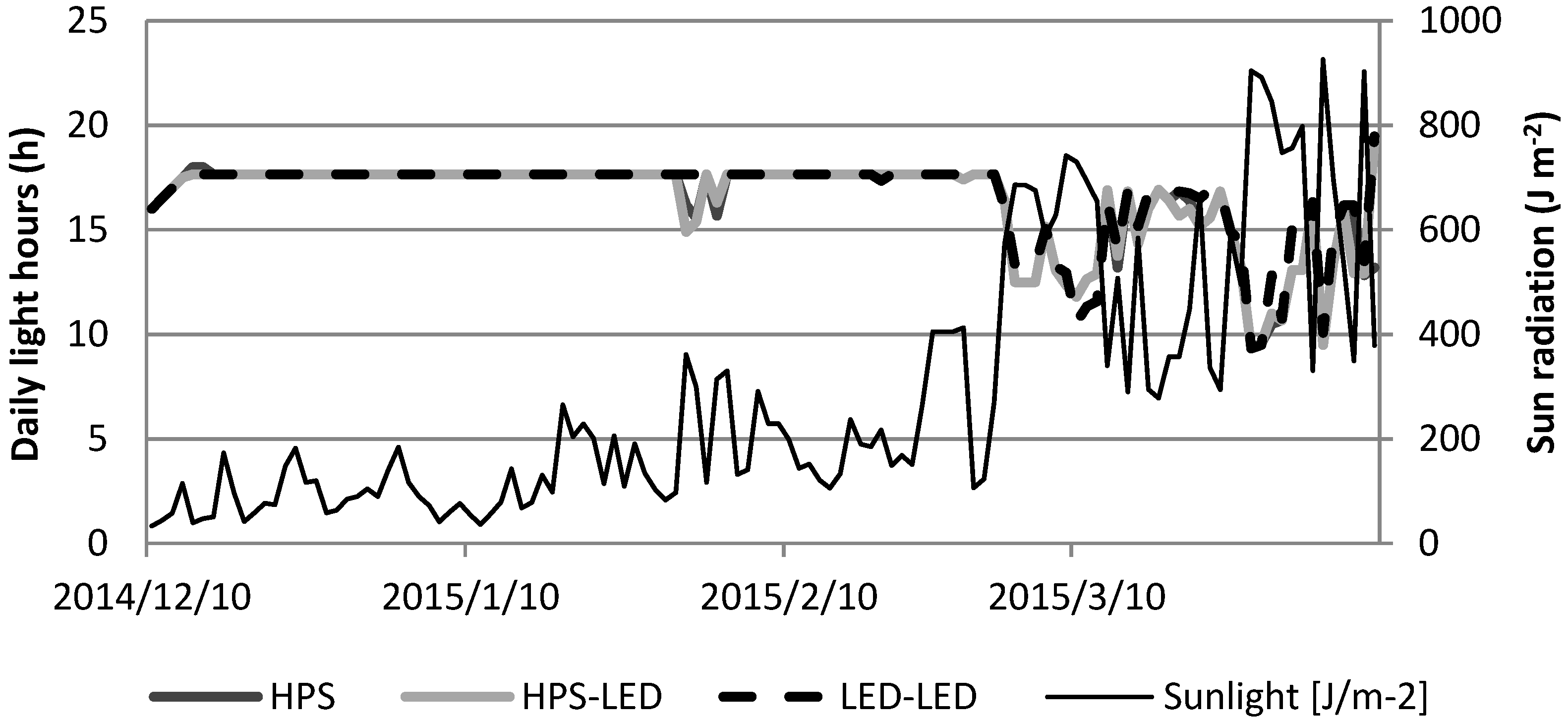
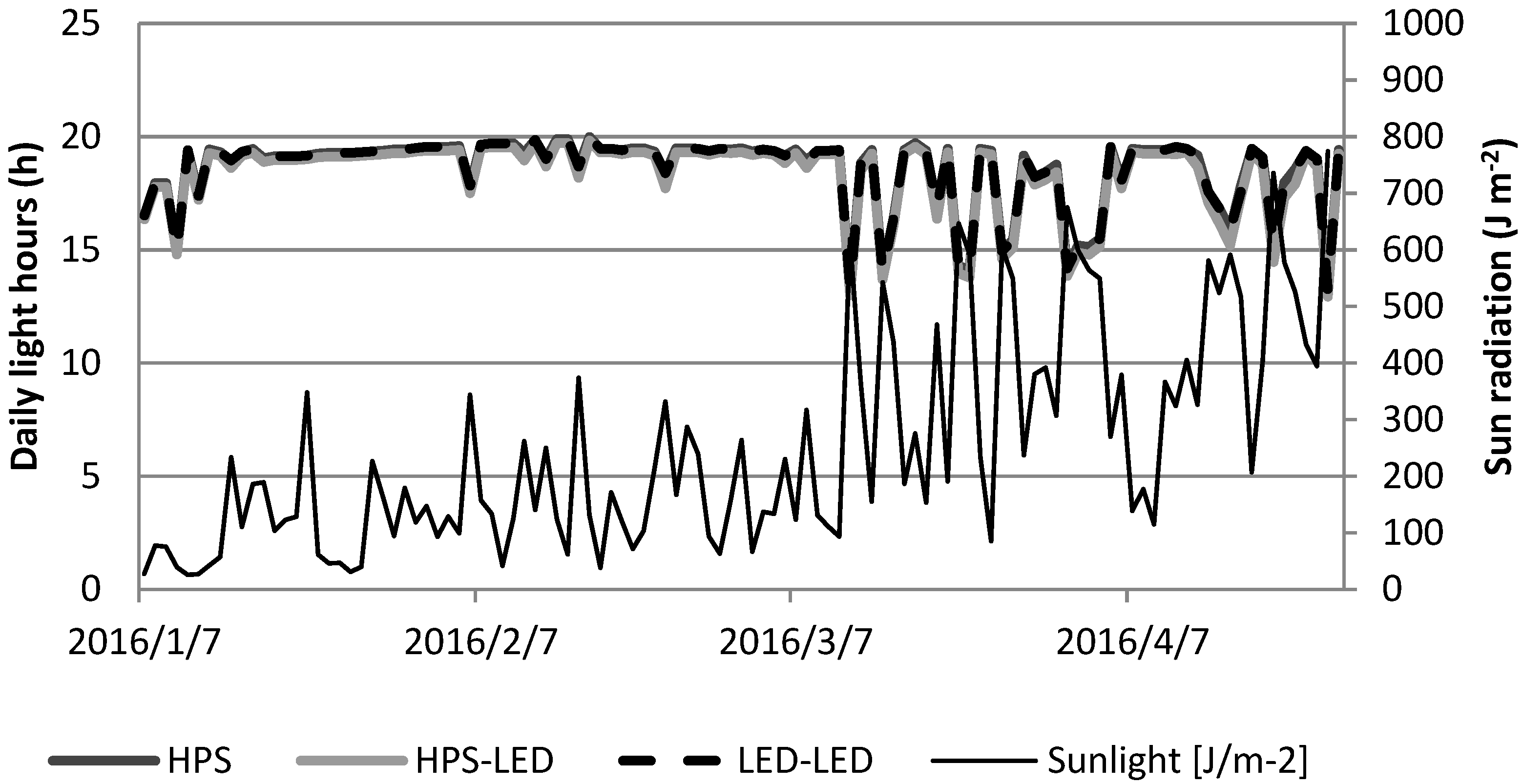
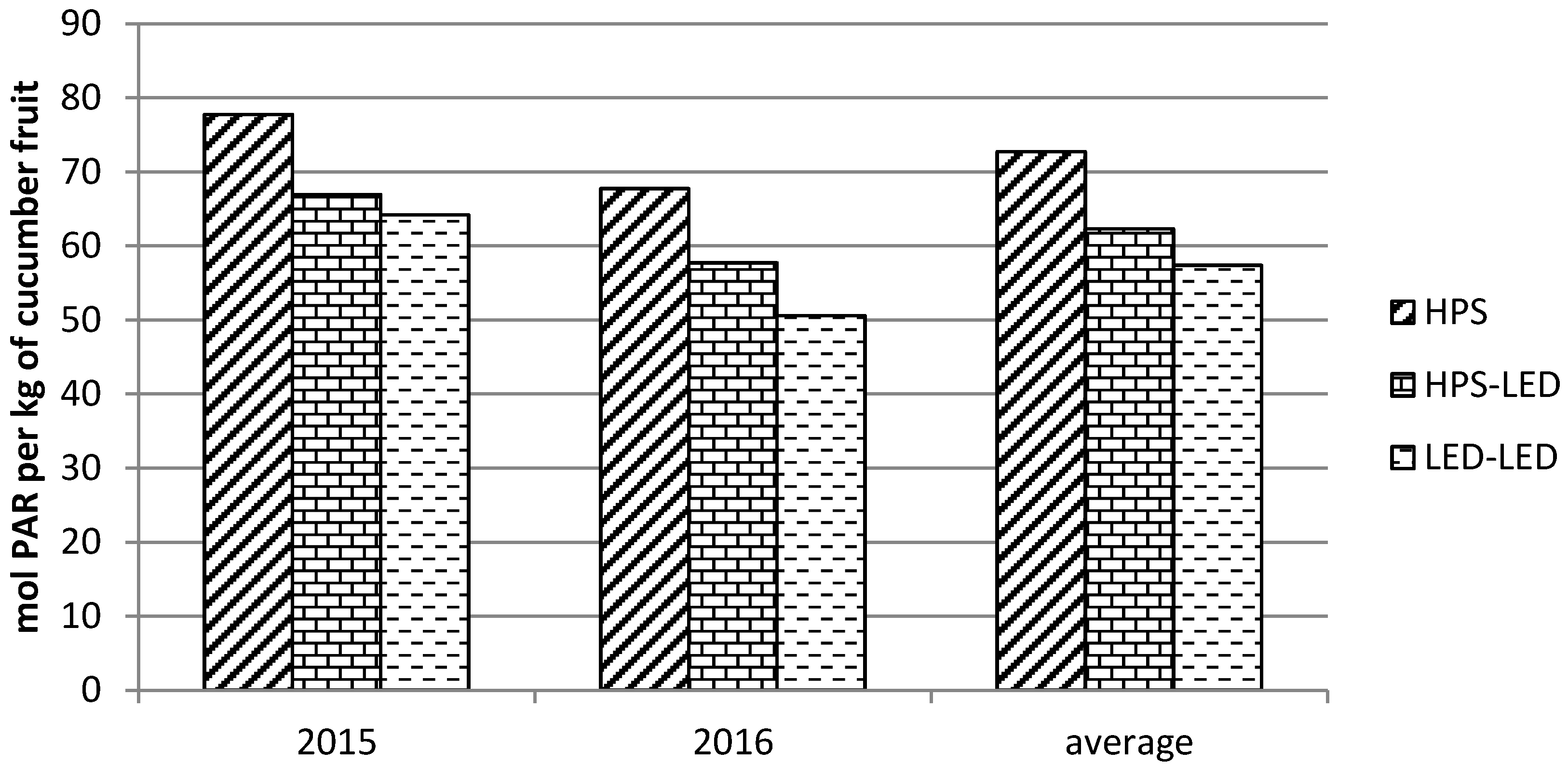
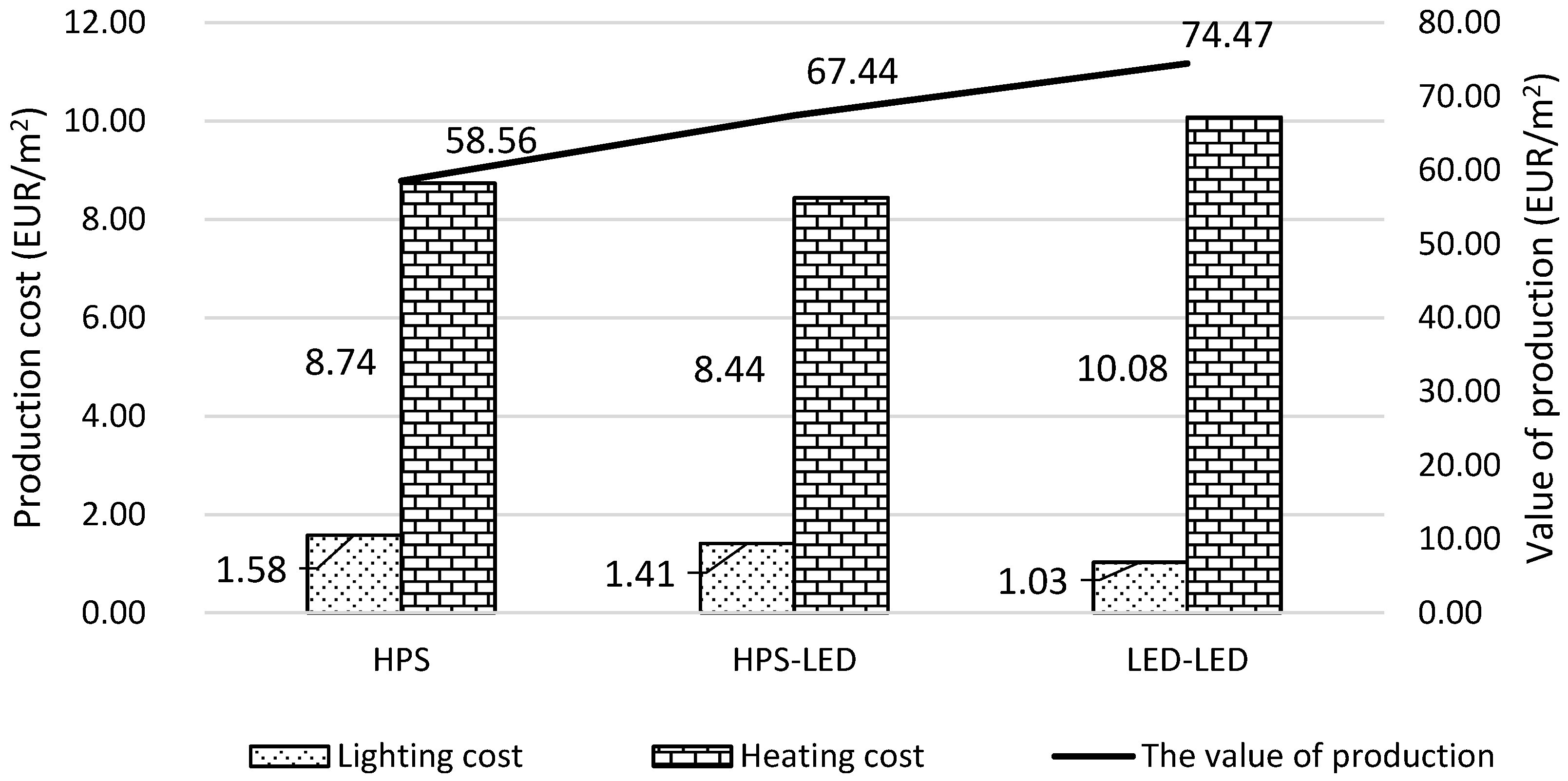
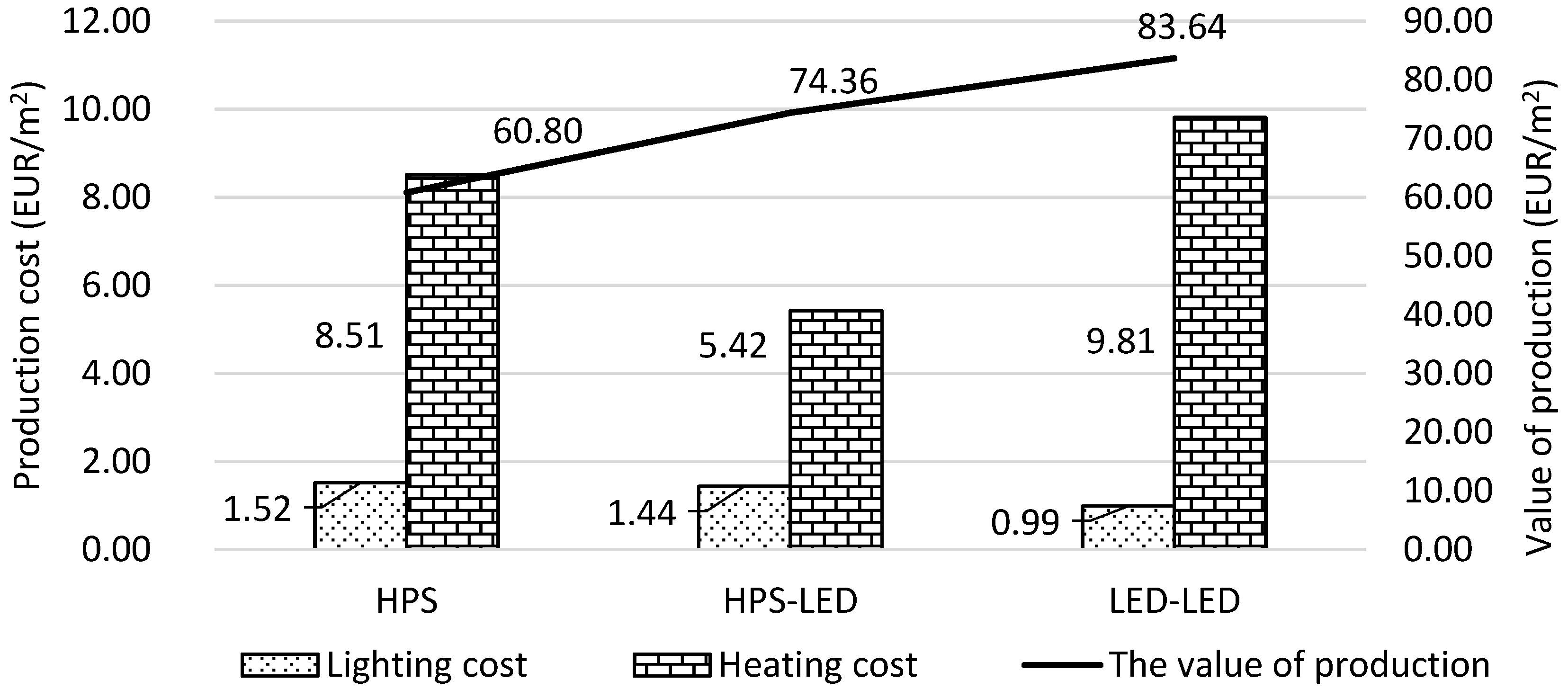
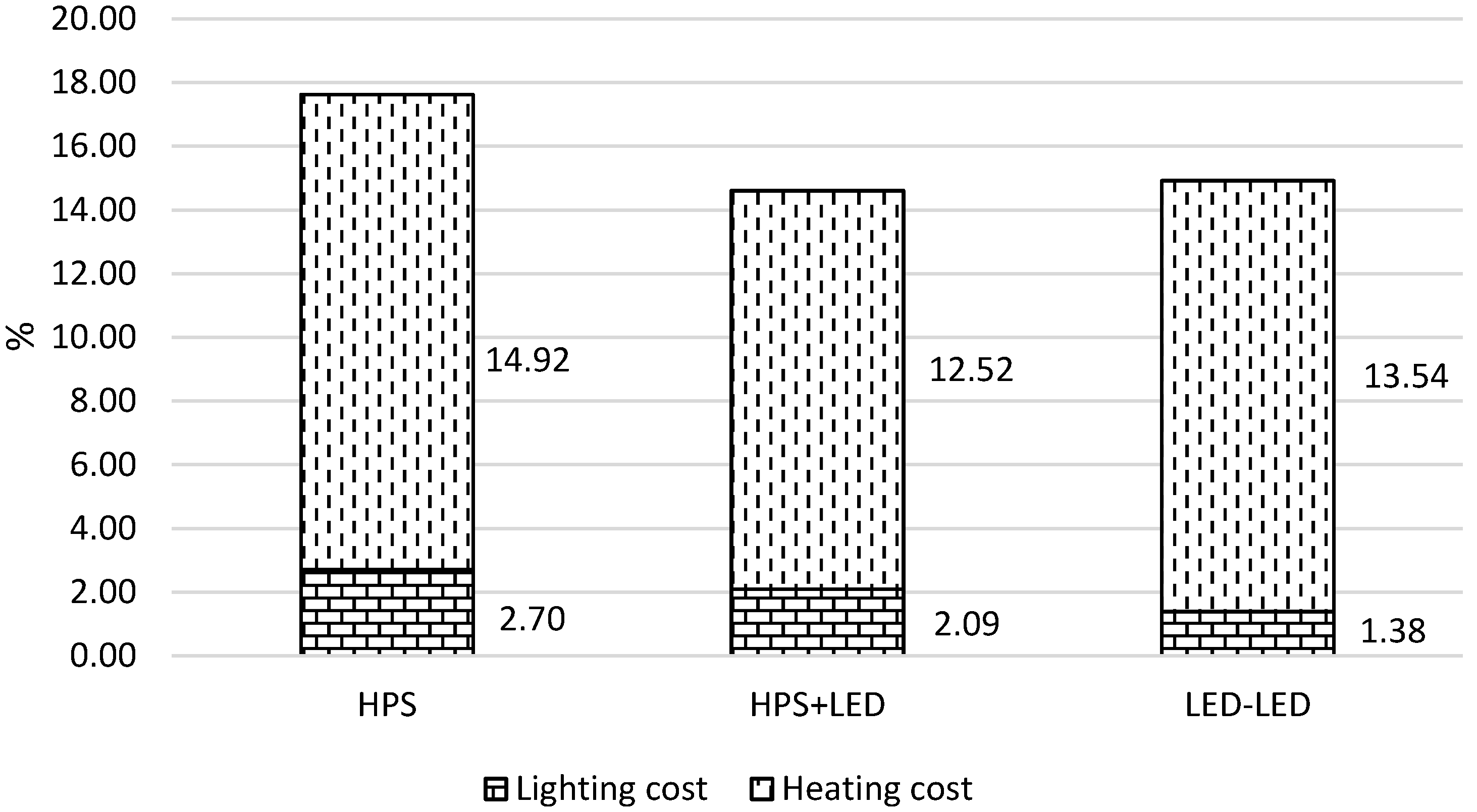
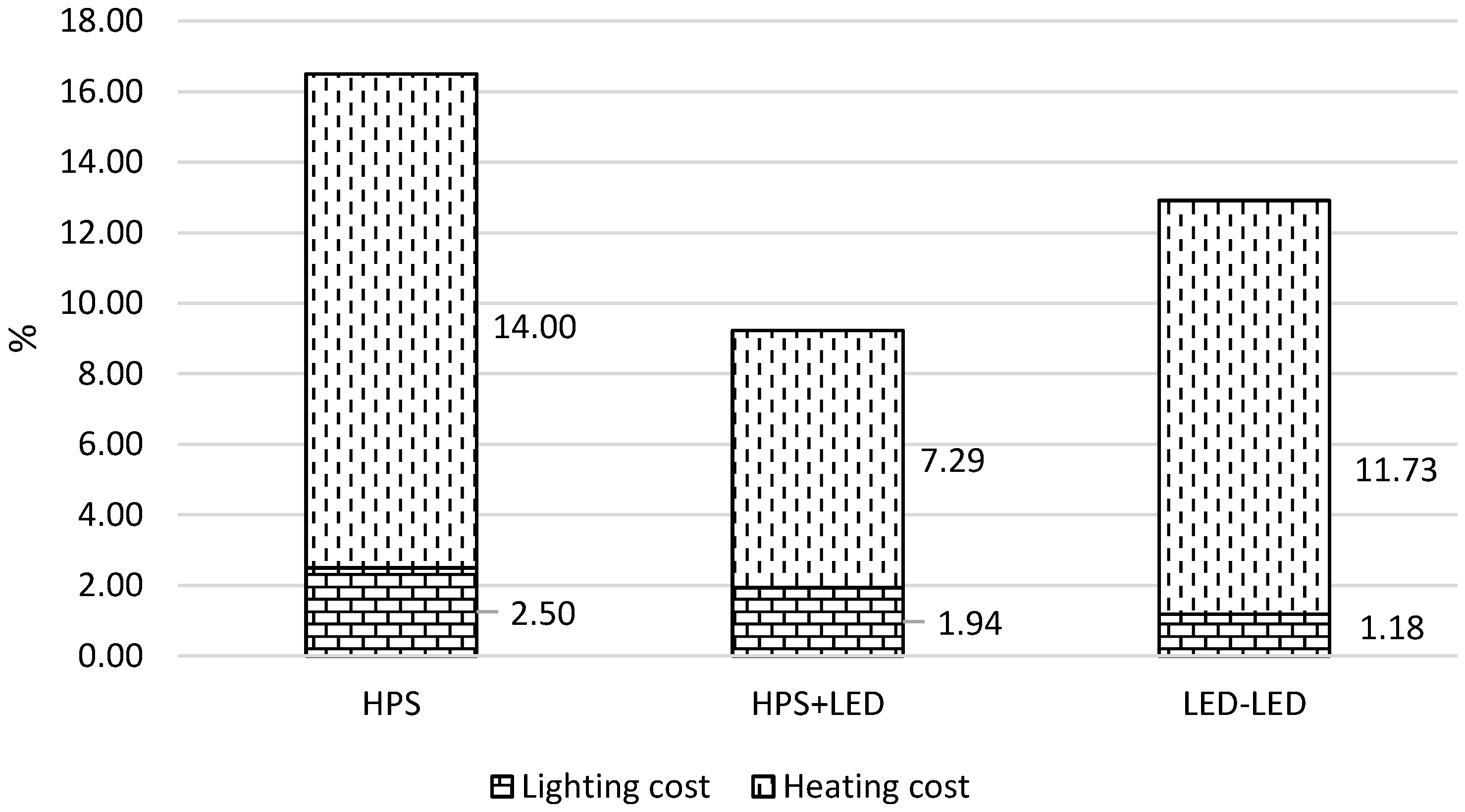
| Specification | Compartment 1 HPS | Compartment 2 HPS-LED | Compartment 3 LED-LED | ||
|---|---|---|---|---|---|
| HPS Top | HPS Top | LED Interlighting | LED Top | LED Interlighting | |
| Number of plants | |||||
| Total 2015 | 125 | 125 | 125 | ||
| per m2 2015 | 3.14 | 3.14 | 3.14 | ||
| Total 2016 | 114 | 146 | 146 | ||
| per m2 2016 | 2.85 | 3.65 | 3.65 | ||
| Number of lamps | 24 | 18 | 18 | 24 | 18 |
| Power in W/pcs | 634 | 634 | 105 | 195 | 105 |
| Power in kW/40 m2 | 14.4 | 10.8 | 1.89 | 4.80 | 1.89 |
| Power in kW/1 m2 | 0.36 | 0.27 | 0.05 | 0.12 | 0.05 |
| Energy consumption in the entire cycle (146 days) 2015 | 550 | 894 | 360 | ||
| Energy consumption in the entire cycle (119 days) 2016 | 529 | 502 | 345 | ||
| Items | HPS | HPS-LED | LED-LED | |||
|---|---|---|---|---|---|---|
| Average Amount (In EUR) | Percentage of Cost | Average Amount (In EUR) | Percentage of Cost | Average Amount (In EUR) | Percentage of Cost | |
| Average variable cost | ||||||
| Seedlings | 1.69 | 4.57 | 1.99 | 5.08 | 2.01 | 5.06 |
| Fertilizers | 9.32 | 25.22 | 11.44 | 29.20 | 11.59 | 29.19 |
| Plant protection | 1.10 | 2.98 | 1.1 | 2.81 | 1.10 | 2.77 |
| Special costs (heating, CO2) | 18.92 | 51.19 | 18.49 | 47.19 | 18.68 | 47.05 |
| Labor costs | 5.93 | 16.04 | 6.16 | 15.72 | 6.32 | 15.92 |
| Total variable cost (TVC) | 36.95 | 100.00 | 39.18 | 100.00 | 39.70 | 100.00 |
| Total revenue (TR) | 59.42 | - | 70.62 | - | 78.76 | - |
| Gross profit (TR –TVC) | 22.47 | - | 31.44 | - | 39.06 | - |
| Gross profit margin (%) | 38.00 | - | 45.00 | - | 50,00 | - |
| Cost Variability Coefficient | HPS | HPS-LED | LED-LED |
|---|---|---|---|
| Total variable costs of which: | 1.23 | 3.97 | 6.90 |
| lighting costs | 0.99 | 0.56 | 1.02 |
| heating costs | 0.69 | 0.37 | 0.70 |
| Specification | Lamp Type | ||
|---|---|---|---|
| HPS 600 W | LED 105 W | LED 195 W | |
| Number of lamps [pcs.] | 24 | 18 | 24 |
| Lamp/fixture life [hours of operation] | 8000/20,000 | 35,000/35,000 | 35,000/35,000 |
| Permissible (recommended) ambient/housing temperature [°C] (affects the lifetime) | 35/75 | 35/40 | 35/40 |
| Current consumption [A] | 2.9–3.1 | 0.6–0.65 | 0.95–1.05 |
| Power consumption [W] | 634 | 105 | 200 |
| Bulb temperature/heat released | 60–70% of power | 40–50% of power | 40–50% of power |
| Possibility of power control | no (possible for power = 1000 W or higher) | yes | yes |
| Permissible voltage drop in the network | 10% but at the expense of operational efficiency and operating time | 20–30% but at the expense of operational efficiency | 20–30% but at the expense of operational efficiency |
| Warm-up time [min.] | 5 min. | none | none |
| Refrigeration [min.] | after cooling down in about 10 min. | none | none |
| Flickering | yes the degree depends on the type of the ballast | no | no |
| Light intensity loss ratio | up to 20% after approx. 2000 h, it is recommended to replace the lamp after 6000–8000 h | up to 10% after about 4–5 years of use (approx. 25,000 h) | up to 10% after about 4–5 years of use (approx. 25,000 h) |
| Price of a set of lamps, net [EURO] | 3680.38 | 4166.27 | 9505.26 |
| Cost of electrical installations, slings and accessories, net [EURO] | 2511.96 | 526.32 (supplemental toplighting) | 1698.56 |
© 2020 by the authors. Licensee MDPI, Basel, Switzerland. This article is an open access article distributed under the terms and conditions of the Creative Commons Attribution (CC BY) license (http://creativecommons.org/licenses/by/4.0/).
Share and Cite
Kowalczyk, K.; Olewnicki, D.; Mirgos, M.; Gajc-Wolska, J. Comparison of Selected Costs in Greenhouse Cucumber Production with LED and HPS Supplemental Assimilation Lighting. Agronomy 2020, 10, 1342. https://doi.org/10.3390/agronomy10091342
Kowalczyk K, Olewnicki D, Mirgos M, Gajc-Wolska J. Comparison of Selected Costs in Greenhouse Cucumber Production with LED and HPS Supplemental Assimilation Lighting. Agronomy. 2020; 10(9):1342. https://doi.org/10.3390/agronomy10091342
Chicago/Turabian StyleKowalczyk, Katarzyna, Dawid Olewnicki, Małgorzata Mirgos, and Janina Gajc-Wolska. 2020. "Comparison of Selected Costs in Greenhouse Cucumber Production with LED and HPS Supplemental Assimilation Lighting" Agronomy 10, no. 9: 1342. https://doi.org/10.3390/agronomy10091342
APA StyleKowalczyk, K., Olewnicki, D., Mirgos, M., & Gajc-Wolska, J. (2020). Comparison of Selected Costs in Greenhouse Cucumber Production with LED and HPS Supplemental Assimilation Lighting. Agronomy, 10(9), 1342. https://doi.org/10.3390/agronomy10091342




